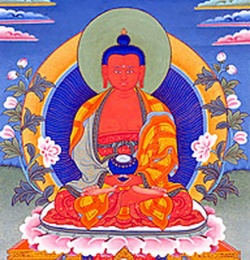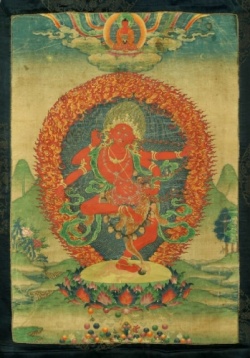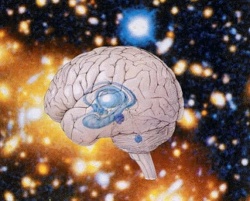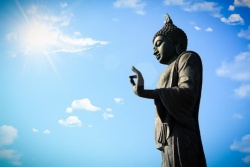Tantra makes use of the strongest experiences of life
Because the Vajrayana experiences the universe as a play of energy, it has no reason to reject any experience. All expressions of energy, even seemingly negative ones, are grist to its mill. If you see things in terms of fixed entities, then you have to reject certain experiences. If you see the world as energy, then at worst you will see energy temporarily locked into limiting or negative patterns. However, you will also see that energy as a resource, a potential which can be liberated.
For the car owner, a wrecked car is useless, something to be towed away. For the scrap dealer it is a resource. Its raw materials can be melted down to make brand new cars. For this reason, the Vajrayana works with negative emotions in different ways from the Sutrayana. The Hinayana approach is to use mindfulness to hold feelings of craving and hatred at arm's length. The Vajrayana, however, accepts these feelings as expressions of Reality just like any other, and as powerful energies to be transmuted. It is because the Tantra rejoices in these energies that it has often been misunderstood.
Some people have criticized it as a mere licence to indulge, others have used it as a mere licence to indulge! We can see here why Tantric training has to be built on experience of the other two yanas. The Tantric practitioner has to have enough insight and self-discipline to play with fire - to ride the most raw and powerful energies of the human psyche on the road to liberation. Without sufficient prior training they will soon throw you and drag you along in an entirely different direction....
We can now begin to understand what the monk, the nun, and the yogin were doing at the beginning of our chapter. The Vajrayana looks at life to see where the most potent energies are to be found, then works to harness them. It does not have to search far. It finds craving and aversion exerting their spells most strongly in the areas of sex and death. So it uses imagery connected with these two great pillars of samsara (as we might call them) to transmute the tremendous powers locked within them. Visualizing beautiful and handsome forms made of light can have a refining, sublimating effect on our erotic drives. However, the Tantra goes further than gazing at, or even becoming, an attractive young Bodhisattva made of light. It uses sexually explicit imagery. It shows Buddhas locked in union with beautiful consorts, in a variety of poses.
These yab-yum (a Tibetan phrase meaning father-mother)5 couples are regarded with particular reverence by Vajrayana devotees, as expressions of the highest truth. To take an example, in the Vajrayana the five Buddhas are frequently shown seated in a sexual embrace with female consorts. In this case we have to understand that the yab-yum couple is really one figure. Just as the four Buddhas around Vairocana are all facets of his Dharmadhatu Wisdom, so when a Buddha takes a yab-yum form this is a way of making explicit different aspects of the Enlightened experience which that Buddha represents.
In a yab-yum figure, the female represents the wisdom aspect of the Enlightened experience, so she is often referred to as the prajna, or wisdom, of the Buddha. The male symbolizes the method or skilful means through which that wisdom is compassionately expressed in the world. Let us briefly meet the consorts of the five Buddhas of the mandala. Entering this mandala from the east, we see Aksobhya embracing his blue consort Locana. Locana means 'she with the eye'. She expresses the clear seeing of the mirror-like wisdom.
In the south, Ratnasambhava embraces the yellow Mamaki. Mamaki means 'mine maker' - not in the sense of mines of jewels, though. Mamaki feels for all living beings as though they were her own children, her own self. They are all hers. She feels as though the whole universe is hers. When you possess her wisdom you think of everything as 'mine'. When everything is yours, when you feel for everyone, then is born the wisdom of equality. In the west, Amitabha embraces the red Pandaravasini (white-robed one).
Pandaravasini is sometimes said to be a form of White Tara. Her white robe also suggests the simile given by the Buddha for the feeling of someone experiencing the fourth dhyana, or meditative absorption. In this state, the Buddha says, you are like someone who on a very hot day takes a cool bath, and then puts on a fresh white robe. White reflects the sun, and radiates light. Similarly, in the fourth dhyana your mind is so positive that its influence radiates and can even positively affect your environment and other people.
So Pandaravasini perhaps expresses not only the discriminating wisdom, but also aspects of meditative experience - with which Amitabha is especially linked through his dhyana mudra. In the north, Amoghasiddhi's consort is Green Tara. Her fearless compassion and instant response to the needs of living beings are expressions of the All-Accomplishing Wisdom. Finally, coming to the centre of the mandala, in its white radiance we see Vairocana in union with the white Akasadhatesvari ('sovereign lady of the sphere of infinite space').
Here, the complementary nature of yab and yum is clearly shown. Vairocana ('illuminator') radiates the light of Buddhahood. Yet for light to radiate there must be space for it to pass through. In the Dharmadhatu Wisdom, light and Emptiness dance together, and are united in one experience. We shall meet with much more sexual imagery in the coming chapters. If we can use such visualizations without being pulled into straightforward sexual desire, then some of the most powerful energies of our psyche will be invested in the quest for Enlightenment. The Vajrayana also employs imagery connected with death.
It loves to use ritual implements made of human bone: there are bone rosaries for counting mantras, trumpets made from human femurs, cups made from human skulls. It employs these things as reminders of death, to accustom us to impermanence. As death is usually what is most feared, handling the remnants of death develops, and symbolizes, fearlessness. Bone implements and skulls are also emblems of Sunyata, because with the experience of Sunyata one's concept of oneself as a fixed ego-entity disappears. Viewed from the standpoint of someone who has not experienced insight into Reality, and still conceives of themself as a fixed ego, the experience of Sunyata can only appear to be a kind of death. Weapons and violence are associated with death.
In the coming chapters we shall meet powerfully built figures with ferocious expressions brandishing axes, choppers, lassos, and other medieval battle implements. The Vajrayana uses magic ritual, and the magical traditions of both East and West have made much symbolic use of weapons for attack or defence against hostile forces. The Tantra uses swords, thunderbolts, and so on, and visualization of wrathful figures, to sublimate aggression and violent tendencies and to express the power of wisdom to smash illusion and hack down suffering.
To give some idea what these wrathful figures are like, we shall take as examples the five Buddhas of the mandala. The Tibetan Book of the Dead describes the appearance, in the bardo or after-death state, of their peaceful forms. These are all expressions of Reality, but if one fails to perceive their empty nature and becomes frightened by them, then from a more alienated perspective Reality begins to assume threatening forms. On the eighth day in the bardo, the Glorious Great Buddha Heruka appears. He is a wrathful deity, powerfully built, and wreathed in flames. His body is the colour of wine.
He has six arms, three heads, and four legs. The text describes him in graphic detail: His body blazes like a mass of light, his nine eyes gaze into yours with a wrathful expression, his eyebrows are like flashes of lightning, his teeth gleam like copper; he laughs aloud with shouts of'a-la-la!' and 'ha-ha!' and sends out loud whistling noises of'shoo-oo!'. He stands on a throne supported by garudas. He is locked in sexual embrace with his consort Buddha Krodhesvari.
Though he appears extremely threatening, the text urges you to recognize him as the wrathful form of the white Buddha Vairocana. Over the four succeeding days, four more Herukas - Buddhas in wrathful form - appear with their consorts. Each is the wrathful form of one of the peaceful Buddhas: Aksobhya, Ratnasambhava, Amitabha, Amoghasiddhi, and Vairocana. Their names show their association with the five Buddha families: Vajra Heruka, Ratna Heruka, Padma Heruka, Karma Heruka, and Buddha Heruka. Their bodies are of a colour corresponding to that of their peaceful form, but rather darker. So, for example, the Karma Heruka, who appears on the twelfth day, is green like Amoghasiddhi,
but of a darker shade.




